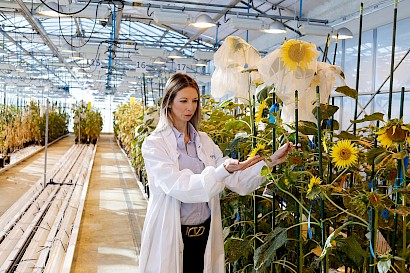A race against time to feed the world
 In this picture, I’m in one of our greenhouses at Syngenta’s Toulouse Innovation Centre in France. I’m checking the quality of sunflowers grown from our experimental seeds. As Syngenta’s head of seed development for commercial growers in Europe, Africa and the Middle East, I oversee work to improve the performance and stress tolerance of crops such as corn, oilseed rape and sunflowers, used to make sunflower oil.
In this picture, I’m in one of our greenhouses at Syngenta’s Toulouse Innovation Centre in France. I’m checking the quality of sunflowers grown from our experimental seeds. As Syngenta’s head of seed development for commercial growers in Europe, Africa and the Middle East, I oversee work to improve the performance and stress tolerance of crops such as corn, oilseed rape and sunflowers, used to make sunflower oil.
The sunflower greenhouse is especially lovely in the cold, dark winter (the picture was taken in March). Our greenhouses are climate- and light-controlled, so we can grow crops in ideal conditions year-round. We can speed up the life cycle of the plant and quickly introduce and check new plant traits. Irrigation and nutrient supply lines feed into the soil beds, and sensors tell us what the crops need.
Syngenta is a global company that supplies large- and small-scale commercial growers. I’ve worked here for 15 years, since I got my undergraduate degree at Lancaster University, UK. These sunflowers have been naturally modified to tolerate pests, including broomrape (Orobanche), a parasitic weed. The tallest sunflowers are mature, and we encase them in mesh to stop pollen from contaminating the samples in which we look for genes relevant to specific traits.
Every year, we try to get products into the hands of farmers more quickly. We use light-emitting diodes and different wavelengths of light to create optimum growing conditions.
I’m excited about using digital agriculture to maximize yields. Farmers can put sensors in their fields to detect and predict plant diseases, and can examine satellite data to pick the best seeds for their soil types and local environment. In Europe, especially, farmers are shifting to practices that are kinder to the soil and are more sustainable long-term. With climate change and a growing global population, we need more output from every single field. It’s a race against time to meet growers’ needs.
You can return to the main Market News page, or press the Back button on your browser.

